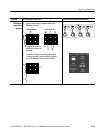
Acquiring Waveforms
CSA7000 Series, TDS7000 Series, & TDS6000 Series Instruments User Manual
3-21
The vertical scale and position controls have the following effects on the vertical
acquisition window and the displayed waveform:
H The vertical volts per division that you set determines the vertical size of the
acquisition window, allowing you to scale it to contain all of a waveform
amplitude or only part. Figure 3--2 on page 3--22 shows two vertical
acquisition windows that contain the entire waveform, but only one window
contains the entire waveform in the graticule on screen.
NOTE. Amplitude-related automatic measurements (for example, peak-to-peak
and RMS) will be accurate for vertical windows like those shown in Figure 3--2a
and b because neither waveform is clipped (that is, both waveforms are
acquired). But if signal amplitude were to extend outside the vertical acquisition
window, the data acquired is clipped. Clipped data causes inaccurate results if
used in amplitude-related automatic measurements. Clipping also causes
inaccurate amplitude values in waveforms that are stored or exported for use in
other programs.
If the scale of a math waveform is changed so that the math waveform is clipped,
it will not affect amplitude measurements on that math waveform.
H The vertical position adjusts the acquisition, and therefore the display, of the
acquired waveform relative to the vertical acquisition window. Figure 3--2b
shows how vertical position moves the acquired waveform vertically in the
acquisition window to place the acquired waveform in the graticule display.
H As you vary the vertical position, the vertical acquisition window moves up
and down (±5 divisions) on the waveform. With input signals that are
smaller than the window, it appears the waveform moves in the window.
Actually, the position moves the vertical acquisition window up and down
on the input signal.


















